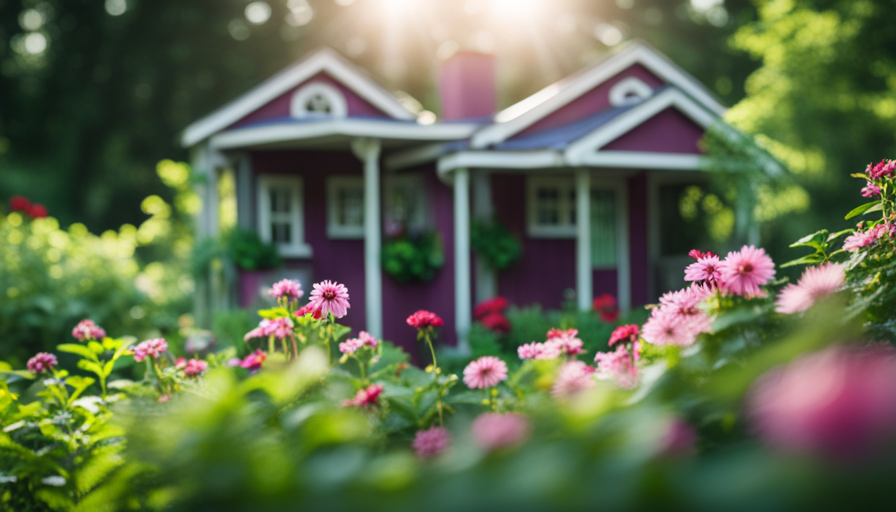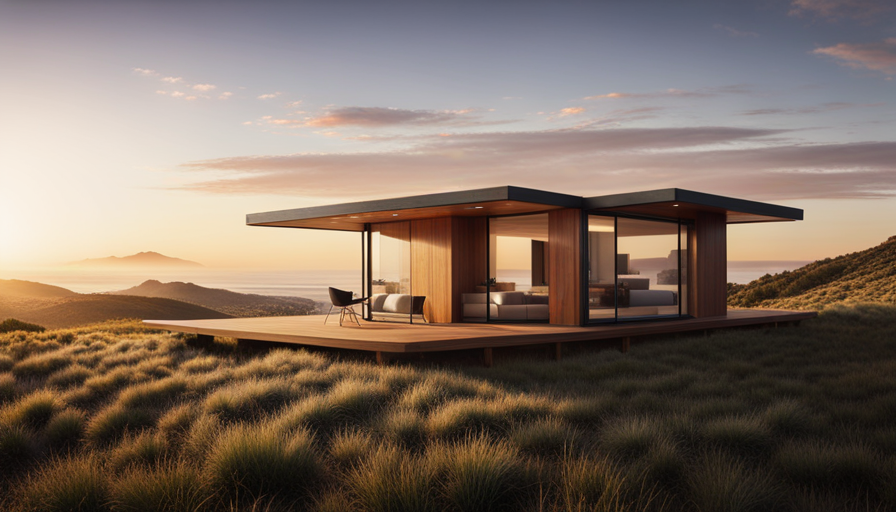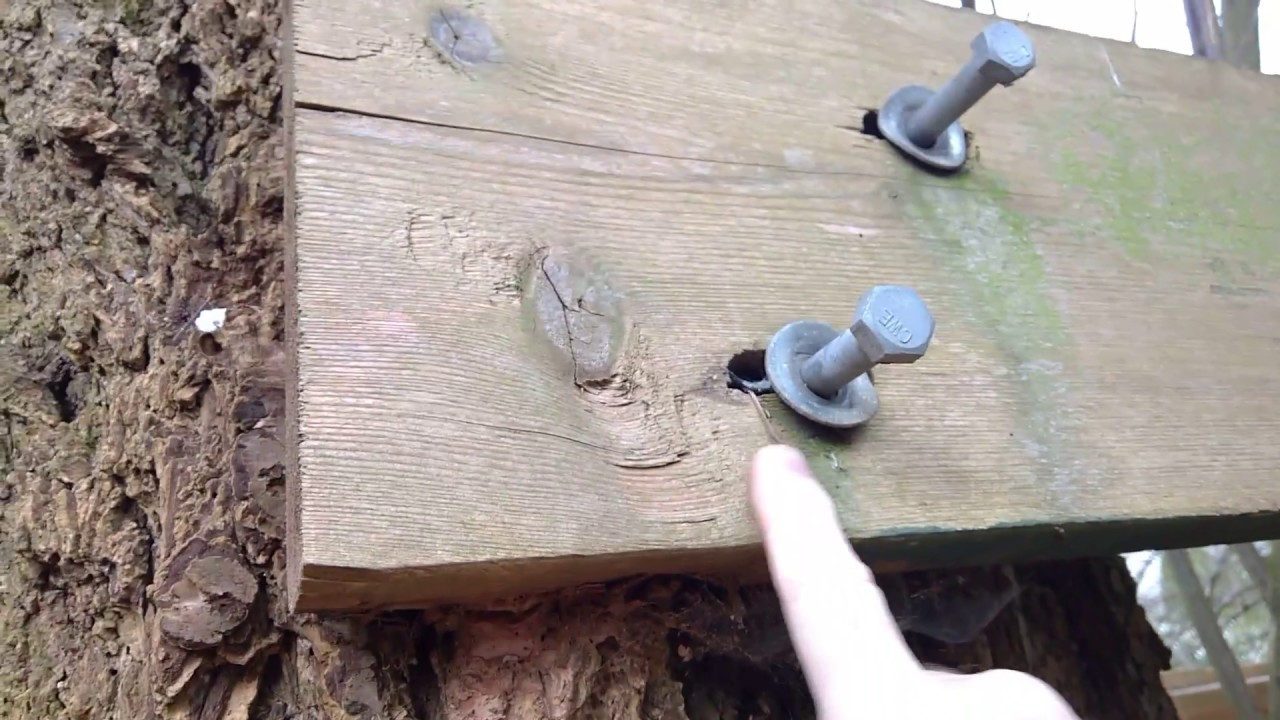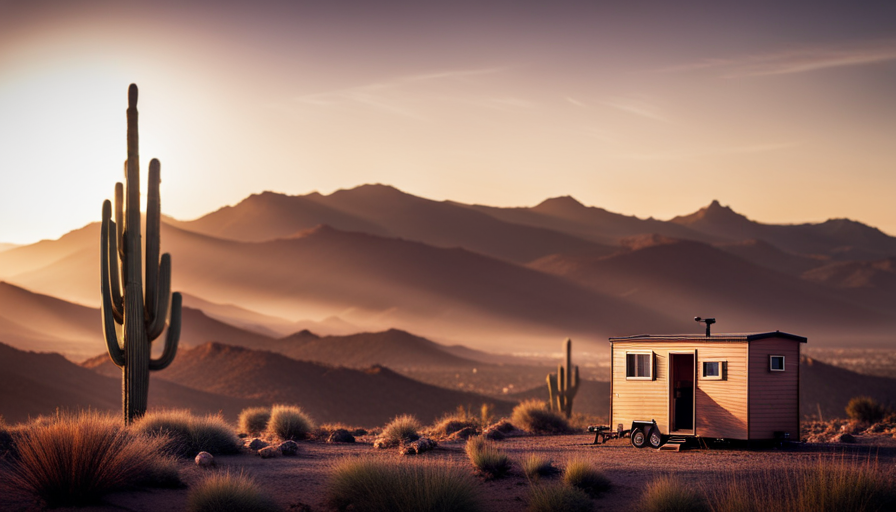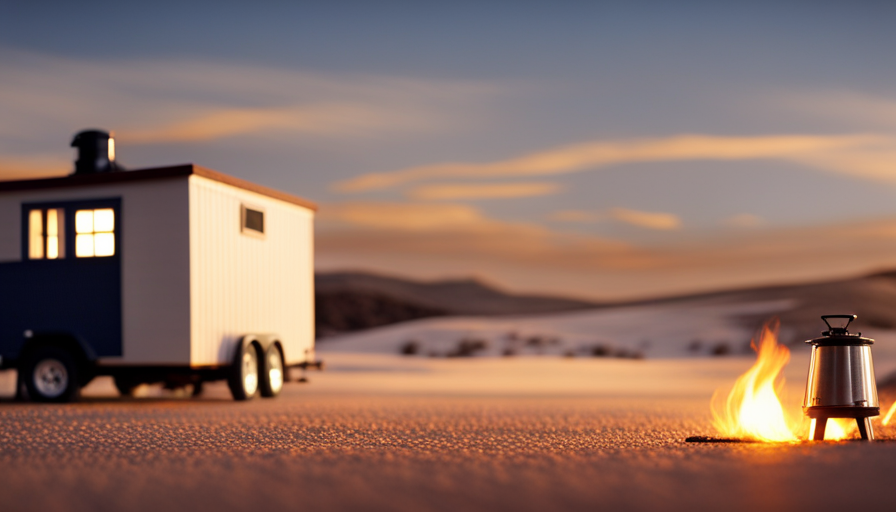In the world of real estate, where bigger sizes have typically been associated with higher value, a new trend is on the rise – the tiny house movement. These small homes are capturing the interest of individuals seeking a simpler, environmentally conscious lifestyle.
But what exactly is the size of a tiny house? As someone who has delved into the world of tiny homes, I can tell you that these abodes are like hidden gems, small but packed with endless possibilities. With an average size of 400 square feet or less, tiny houses challenge our conventional notions of space. But don’t let their size fool you – they offer a multitude of benefits, from reduced costs to a smaller environmental footprint.
In this article, we will delve into the world of tiny houses, exploring their size requirements, design considerations, and whether this unique lifestyle is right for you. Get ready to discover the big wonders of living small!
Key Takeaways
- Tiny houses typically measure less than 400 square feet.
- They challenge conventional notions of space and emphasize minimalism, affordability, and sustainability.
- They require careful consideration of needs and preferences, with size restrictions and potential height restrictions depending on the location.
- Tiny houses maximize space through clever storage solutions and multifunctional furniture, utilizing every square inch efficiently for maximum functionality.
Definition of a Tiny House
If you’re looking for a clear and concise definition of a tiny house, you’ll find that it refers to a dwelling that typically measures less than 400 square feet.
The size restrictions of a tiny house are an integral part of the tiny house movement, a growing trend that emphasizes minimalism, affordability, and sustainability. These small, compact homes have gained popularity for their ability to provide a simpler and more efficient way of living. Despite their diminutive size, tiny houses are designed to maximize space, often incorporating clever storage solutions and multifunctional furniture.
The concept of a tiny house goes beyond just the physical dimensions; it embodies a lifestyle that encourages people to prioritize experiences and relationships over material possessions. Understanding the size requirements of a tiny house is essential for those considering this alternative way of living. It involves careful consideration of one’s needs and preferences, as well as a willingness to embrace a more minimalist lifestyle.
Transitioning into the subsequent section about understanding the size requirements, it is crucial to explore the various factors that influence the design and layout of a tiny house.
Understanding the Size Requirements
When it comes to these compact dwellings, it’s like fitting all the essentials of a cozy nest into a matchbox. Tiny houses are known for their small size, but what exactly are the size requirements? Well, the answer isn’t so straightforward.
While there is no strict definition, there are some general guidelines to consider. In order to be considered a tiny house, the living space should be no more than 400 square feet. This includes both the interior and exterior dimensions. Additionally, there may be height restrictions depending on the location.
Space limitations are a key factor when it comes to tiny houses. Every square inch needs to be utilized efficiently to maximize functionality. This means incorporating clever storage solutions, multi-purpose furniture, and creative design ideas. It’s all about making the most of the available space.
Living in a tiny house may seem challenging, but it also comes with numerous benefits. From reduced costs and environmental impact to a simpler and more minimalist lifestyle, there are many advantages to downsizing.
So, let’s explore the benefits of living in a tiny house and how it can positively impact your life.
Benefits of Living in a Tiny House
Imagine the freedom and simplicity of embracing a minimalist lifestyle in a cozy sanctuary that not only reduces your environmental impact but also saves you money. Living in a tiny house offers numerous benefits that go beyond just the size of the space. It allows you to focus on what truly matters, decluttering your life and simplifying your daily routines. By adopting a minimalist lifestyle, you can free yourself from the burden of excess possessions and find contentment in the essentials.
One of the biggest advantages of living in a tiny house is the financial freedom it provides. With a significantly smaller mortgage or rent payment, you can redirect your funds towards other priorities such as saving for the future or traveling. The reduced utility costs also contribute to your financial well-being, as these small dwellings require less energy to heat, cool, and power.
To give you a visual representation of the financial benefits of living in a tiny house, consider the following table:
| Traditional House | Tiny House | |
|---|---|---|
| Mortgage | $1,500 | $500 |
| Utilities | $300 | $100 |
| Total Cost | $1,800 | $600 |
As you can see, the savings can be substantial. Transitioning into the subsequent section about the challenges of living in a compact space, it’s important to acknowledge that while living in a tiny house offers many advantages, it also comes with its own set of challenges.
Challenges of Living in a Compact Space
Living in a compact space can present challenges in terms of limited storage and restricted movement. One of the biggest challenges of living in a tiny house is finding enough storage space for all your belongings. With limited square footage, it can be difficult to find places to store items like clothing, kitchenware, and other personal belongings. This often requires creative solutions such as utilizing vertical space with shelves and hooks, or investing in multi-functional furniture with built-in storage compartments.
Another challenge is the restricted movement within a small living area. In a tiny house, you may find yourself constantly bumping into furniture or squeezing through narrow pathways. It can be frustrating to not have the freedom to move around easily, especially if you have guests or pets. Additionally, living in close quarters with others can lead to a lack of privacy, which can be challenging for some individuals.
Transitioning into the next section about design and layout considerations, it’s important to keep these challenges in mind when planning the design of a tiny house. By carefully considering the layout and incorporating smart storage solutions, you can help alleviate some of the challenges that come with living in a compact space.
Design and Layout Considerations
To maximize your living experience in a compact space, careful consideration of the design and layout is crucial. Design aesthetics play a significant role in creating a comfortable and visually appealing tiny house. By incorporating elements such as natural light, open floor plans, and clever storage solutions, you can create a space that feels larger than its actual size.
When it comes to space optimization, every square inch counts. To help you visualize the possibilities, here is a table showcasing three key design and layout considerations for tiny houses:
| Design Consideration | Benefits | Example |
|---|---|---|
| Natural Light | Brightens the space | Large windows, skylights |
| Open Floor Plans | Creates a sense of spaciousness | Removing walls, multifunctional rooms |
| Clever Storage Solutions | Maximizes usable space | Under stairs storage, hidden compartments |
By carefully incorporating these design elements, you can create a tiny house that feels both functional and inviting. It’s important to remember that the layout should be tailored to your specific needs and lifestyle.
In the subsequent section about maximizing storage in a small space, we will explore how to make the most out of every nook and cranny.
Maximizing Storage in a Small Space
One key aspect to consider when designing a tiny house is how to make the most out of limited space by maximizing storage options. In a small space, every square inch counts, so it’s essential to come up with creative organization ideas and maximize storage solutions.
There are numerous ways to maximize storage in a tiny house. One option is to utilize vertical space by installing tall cabinets and shelving units. This allows you to take advantage of the height of the room and store items that aren’t frequently used on higher shelves.
Additionally, utilizing under-bed storage or incorporating storage solutions that fit under stairs can help maximize space.
Another creative storage solution is to utilize multi-functional furniture. For example, consider incorporating a bed with built-in drawers or a dining table that doubles as a workspace. These innovative furniture pieces not only provide storage but also serve multiple purposes, saving valuable space.
Maximizing storage in a tiny house requires thinking outside the box and utilizing creative organization ideas. By incorporating vertical storage options and multi-functional furniture, you can make the most out of limited space.
This seamlessly transitions into the subsequent section about innovative furniture and multi-functional design.
Innovative Furniture and Multi-functional Design
Get ready to experience the magic of space-saving furniture that transforms your small abode into a versatile and efficient haven. When it comes to innovative space-saving solutions and creative interior design, tiny house owners have truly mastered the art of maximizing their limited space. Here are some examples of how they make the most out of their tiny homes:
- Nested bullet point list:
- Wall-mounted foldable tables and desks that can be easily tucked away when not in use, creating more floor space for other activities.
- Loft beds with built-in storage compartments underneath, providing ample space for stowing away clothes, bedding, and personal belongings.
Additionally, tiny house owners often use multi-functional furniture pieces, such as sofa beds or ottomans that double as storage containers. These clever design choices not only save space but also add a touch of style to the interior.
As we delve into the next section on cost considerations and affordability, it’s important to note that the innovative furniture and multi-functional design in tiny houses not only maximize storage but also contribute to cost savings.
Cost Considerations and Affordability
Imagine how much money you can save by carefully considering the costs and affordability of your home, taking into account factors such as material choices, energy efficiency, and long-term maintenance.
When it comes to tiny houses, cost analysis and financial feasibility are key considerations. Building a tiny house can be more affordable compared to traditional homes, as the smaller size means less material is needed. Additionally, the cost of utilities and maintenance can be significantly reduced due to the smaller space. However, it’s important to consider the upfront costs of building a tiny house, including permits, land, and construction materials. It’s also crucial to factor in ongoing expenses such as insurance and property taxes. Conducting a thorough cost analysis will help ensure that the financial aspects of tiny house living are feasible for your budget.
Transitioning to the subsequent section about the environmental impact of tiny house living, it’s important to note that the affordability of tiny houses often goes hand in hand with their sustainability.
Environmental Impact of Tiny House Living
Considering the environmental impact of living in a small, eco-friendly dwelling like a tiny house, it’s incredible to envision the positive ripple effect of reduced energy consumption and carbon footprint.
Tiny houses are designed with environmental sustainability in mind, and they offer several benefits in terms of minimizing our impact on the planet.
Here are three key ways in which tiny house living contributes to a minimal carbon footprint and promotes environmental sustainability:
-
Energy Efficiency: Tiny houses are typically built with energy-efficient features such as solar panels, LED lighting, and high-quality insulation. These features help reduce energy consumption and lower greenhouse gas emissions, making them an eco-friendly choice.
-
Reduced Material Usage: The construction of a tiny house requires far fewer materials compared to a traditional home. This means fewer resources are extracted from the earth, resulting in less environmental degradation.
-
Sustainable Living Practices: Living in a tiny house encourages a simpler and more sustainable lifestyle. With limited space, individuals are motivated to downsize and consume less. This leads to less waste generation and a greater focus on reusing and recycling.
Considering the environmental benefits, it’s worth exploring whether tiny house living is right for you and your lifestyle.
Is Tiny House Living Right for You?
Moving on from discussing the environmental impact of tiny house living, let’s now dive into the question of whether or not tiny house living is right for you.
It’s important to consider both the pros and cons before making a decision that will greatly impact your lifestyle.
One of the major advantages of tiny house living is the financial freedom it can provide. With a smaller space comes reduced costs for utilities, maintenance, and even the initial purchase price. This can free up your budget for other priorities such as travel, hobbies, or savings. Additionally, living in a tiny house encourages a minimalist lifestyle, forcing you to prioritize and declutter your belongings.
However, it’s important to acknowledge that tiny house living also requires significant lifestyle adjustments. The limited space means you have to be extremely organized and efficient with your belongings. It may also require you to downsize your possessions, which can be a difficult process for some. Additionally, living in close quarters can test relationships and require open communication and compromise.
Ultimately, whether or not tiny house living is right for you depends on your personal preferences and priorities. It’s crucial to thoroughly evaluate the pros and cons, and consider how you would adapt to the lifestyle adjustments that come with living in a tiny house.
Frequently Asked Questions
Are tiny houses legally allowed in all areas?
Yes, tiny houses aren’t legally allowed in all areas.
There are certain restrictions and regulations that vary depending on the location. Many cities have minimum square footage requirements for residential dwellings, which tiny houses often don’t meet.
Additionally, zoning laws may prohibit tiny houses from being used as primary residences or restrict them to specific areas.
It’s important to research and understand the local regulations before deciding to build or live in a tiny house.
Can I build a tiny house on my own or do I need professional help?
I can definitely build a tiny house on my own without professional help. However, it’s important to be knowledgeable about building codes and regulations in your area.
Familiarize yourself with the construction process, including framing, plumbing, electrical work, and insulation. It’s also essential to have the right tools and materials to ensure a safe and sturdy structure.
Don’t forget to consult local authorities and obtain any necessary permits before starting your project.
What are the insurance requirements for a tiny house?
Insurance requirements for a tiny house can vary depending on the size and location. It’s crucial to have adequate insurance coverage to protect your investment. Building codes play a significant role in insurance requirements, as they ensure the house meets safety standards.
Insurance typically covers property damage, liability, and theft. Additionally, some insurance companies offer specialized coverage for tiny houses, taking into account their unique needs. It’s essential to consult with an insurance professional to determine the specific requirements for your tiny house.
How do I find a suitable location to park my tiny house?
Finding a suitable location for my tiny house involves navigating zoning laws and finding affordable and accessible land. To navigate zoning laws, I recommend researching local regulations and contacting zoning departments for clarification.
When it comes to finding affordable and accessible land, consider looking for rural areas, cooperative communities, or private landowners willing to rent or sell. Additionally, joining online tiny house communities and attending tiny house events can provide valuable networking opportunities for finding suitable parking locations.
What are the zoning regulations for tiny houses in different municipalities?
Zoning restrictions and building permits for tiny houses vary across different municipalities. It’s important to research and understand the regulations in your specific area before parking your tiny house.
Zoning regulations typically determine where tiny houses can be located, such as residential or mixed-use areas. Building permits may be required for construction, ensuring that the tiny house meets safety and quality standards.
Contact your local government or planning department for specific information on zoning regulations and building permits for tiny houses in your area.
Conclusion
After exploring the world of tiny houses, I can confidently say that these compact dwellings are a unique and appealing housing option.
Contrary to popular belief, the size of a tiny house can vary, but typically ranges from 100 to 400 square feet.
Living in a tiny house offers numerous benefits, such as reduced costs, environmental sustainability, and a simpler lifestyle. However, it also presents challenges in terms of space limitations.
Ultimately, whether or not tiny house living is right for you depends on your personal preferences and priorities.
Hi, I’m Emma. I’m the Editor in Chief of Tiny House 43, a blog all about tiny houses. While tree houses are often associated with childhood, they can be the perfect adult retreat. They offer a cozy space to relax and unwind, surrounded by nature. And since they’re typically built on stilts or raised platforms, they offer stunning views that traditional homes simply can’t match. If you’re looking for a unique and romantic getaway, a tree house tiny house might just be the perfect option.
